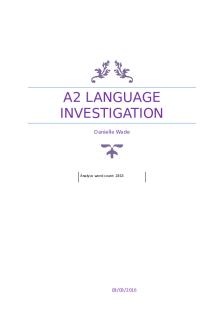Identifying Structural Features Spoken Language - A-LEVEL ENGLISH PDF

| Title | Identifying Structural Features Spoken Language - A-LEVEL ENGLISH |
|---|---|
| Author | Imogen Martin |
| Course | English Language & Literature - A2 |
| Institution | Sixth Form (UK) |
| Pages | 1 |
| File Size | 98.7 KB |
| File Type | |
| Total Downloads | 10 |
| Total Views | 131 |
Summary
Identifying Structural Features Spoken Language - A-LEVEL ENGLISH / ENGLISH LITERATURE & LANGUAGE SPOKEN LANGUAGE TOPIC...
Description
IDENTIFYING STRUCTURAL FEATURES: Lance Armstrong Transcript: •
Use of turn – taking – initially they take turns speaking and formally approach the interview but this changes later on in the interview.
•
Discourse Markers – used frequently throughout, show nervousness, use of negative politeness and topic-shifting.
•
Adjacency pairs - broken through double questioning.
•
Interruptions and overlaps – shows building tension, defensive and accusatory tone is presented from the interviewer and interviewee.
•
Vague language (doesn’t make point very well and is very blank) and pausing shows lack of fluency – shows pressure of interview and shows Lance as being defensive, his language is breaking down. Use of non-fluency features, elongation and fillers shows he tries to create time to think and justify himself.
•
Lance Uses Hedging – avoids responding to the interviewer.
•
Use of Negative Politeness – Lance restructures his speech frequently to try and prevent a face threating act but the interviewer constantly is on the edge of possibly committing a face threatening act.
•
Face Threatening Act – interviewer breaches upon this and this frustrates Lance and causes tension within the interview.
•
Avoidance of responsibility – Lance pushes blame onto government to avoid the main issue being asked about.
•
Use of First person inclusive pronoun ‘we’ – Lance doesn’t want to accept individual responsibility for his actions. He tries to avoid the interview being a personal attack on him, he feels as though he is a ‘scape goat’ for the scandal.
•
Paralinguistic laughing – This shows Lance’s nervousness and shows that he is uncomfortable.
•
Backchanneling - goes back on himself and questions what he has said before, he backtracks and thinks about what he is saying.
•
Emphatic – he is not comfortable in the situation and shows this clearly.
•
Power – power shifts between both the interviewer and interviewee. When Lance gains power the interviewer takes the floor and interrupts him and takes control and directs the conversation.
•
Interviewer wants to get to the truth – it is his job to find out the truth about the situation and he does this by interrogating Lance.
•
Lance tries to get sympathy – he talks about his experience with the American Police and government. He repeats the dynamic verb ‘forced’ twice to emphasise how he feels but changes this to ‘compelled’ which could show manipulation of the situation. He talks about the police knocking on his door and threatening him which is an attempt to gain sympathy.
•
Use of interrogatives – interviewer is trying to get to the point and get the truth....
Similar Free PDFs

Language features glossary
- 4 Pages

1500 Vocabulary Words For Spoken English
- 150 Pages

English Language Teaching
- 9 Pages

English Language Teaching
- 7 Pages

English Language investigation
- 26 Pages

A level English Language
- 18 Pages

English Language - Jonathan Culpeper
- 33 Pages

English Language Teaching
- 16 Pages

English language terms
- 1 Pages

Practical English Language Teaching.pdf
- 353 Pages
Popular Institutions
- Tinajero National High School - Annex
- Politeknik Caltex Riau
- Yokohama City University
- SGT University
- University of Al-Qadisiyah
- Divine Word College of Vigan
- Techniek College Rotterdam
- Universidade de Santiago
- Universiti Teknologi MARA Cawangan Johor Kampus Pasir Gudang
- Poltekkes Kemenkes Yogyakarta
- Baguio City National High School
- Colegio san marcos
- preparatoria uno
- Centro de Bachillerato Tecnológico Industrial y de Servicios No. 107
- Dalian Maritime University
- Quang Trung Secondary School
- Colegio Tecnológico en Informática
- Corporación Regional de Educación Superior
- Grupo CEDVA
- Dar Al Uloom University
- Centro de Estudios Preuniversitarios de la Universidad Nacional de Ingeniería
- 上智大学
- Aakash International School, Nuna Majara
- San Felipe Neri Catholic School
- Kang Chiao International School - New Taipei City
- Misamis Occidental National High School
- Institución Educativa Escuela Normal Juan Ladrilleros
- Kolehiyo ng Pantukan
- Batanes State College
- Instituto Continental
- Sekolah Menengah Kejuruan Kesehatan Kaltara (Tarakan)
- Colegio de La Inmaculada Concepcion - Cebu





